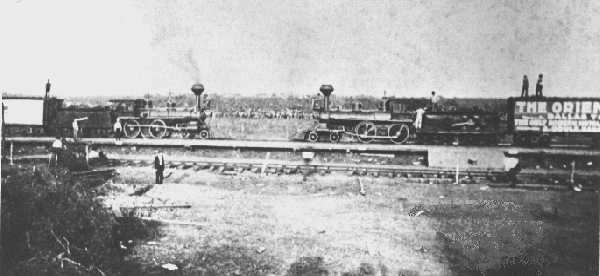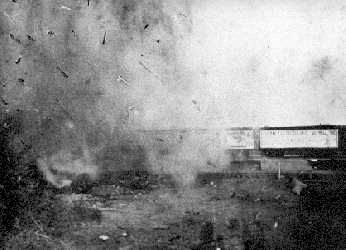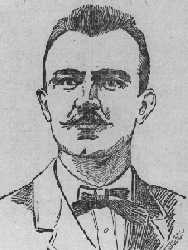By 5 p.m. the afternoon of September 15, 1896, nearly 50,000 people had gathered anxiously on a wide stretch of Texas prairie near Waco. Moments later, they watched two 35-ton locomotives, each pulling seven boxcars, collide head-on at a combined speed of 120 miles per hour. The publicity spectacular was staged at Crush, Texas, a short-lived town established just for the occasion. The organizer for the event (and namesake for the town) was William George Crush, a passenger agent for the Missouri, Kansas & Texas Railway Company, commonly known as “the Katy.”
The collision, intended as publicity for the railroad, was planned and promoted for months in advance. The locomotives, Old No. 999 and Old No. 1001, were displayed prominently during tours throughout the state.
Rather than the usual entrance fees charged for major public attractions, Katy officials announced that they would charge no admission for the well-publicized event. Further, they promised that food concession contractors would not be allowed to sell lunches at extortionate prices and that containers of “fresh Waco water” would be abundant and free. The only fee would be the train fare required to transport the many thousands of spectators to the crash site. Even these fares were offered at bargain rates–none over $5 from anywhere in Texas. As a result, the excursion trains were so packed that some people were obliged to ride on top of the cars for lack of room inside.
As a promotional stunt, however, Katy’s well-laid plans turned sadly sour. At the instant of impact, one of the boilers unexpectedly exploded. As a result, bolts and scraps of iron and debris were hurled hundreds of yards, some into the spectator area. Two spectators were killed and a few more seriously injured.
Within hours, the Katy cranes had removed the larger debris; souvenir seekers took care of the rest. Crush (the town), which that afternoon had been the second-largest city in Texas, was fully depopulated by midnight. Crush (the promoter), who had been assured by railroad engineers that it was virtually impossible for a boiler to explode in the collision, was fired that evening by railroad management. The railroad relented, however, and he was rehired the next day. Except for this single flamboyant episode, Crush was a relatively conservative citizen and employee who later retired with 57 years of service with the railroad.
Despite its failure as a promotion for the railroad, the Crash at Crush remained a key topic of discussion for many months before its memory slowly faded. It is not now known whether Scott Joplin, the great ragtime music composer from Texas, was one of the spectators on that September afternoon in 1896. Twenty-seven-year-old Joplin was sufficiently impressed with the event, however, that by year-end he had composed The Great Crush Collision, one of the earliest of his many compositions.
Today, one hundred years later, there are few visible signs that the event ever took place. A roadside marker was placed at the site off I-35 just south of West in 1977. Other than that, all that is left of the Crash at Crush is a few old newspaper accounts, court records, some remarkable photographs, and the song written by Joplin.
Primary Reference:
George B. Ward, The Crash at Crush: Texas’ Great Pre-arranged Train Wreck, Master’s Report, The University of Texas at Austin, May, 1975.


